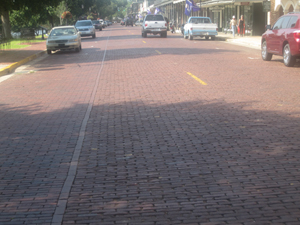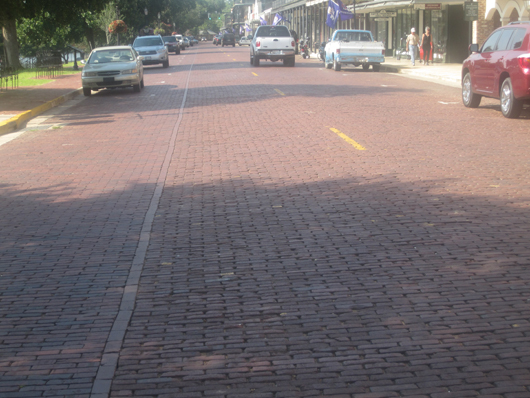
WILMINGTON, N.C. (AP) – In some of the oldest parts of Wilmington, shaded brick streets welcome you into calm neighborhoods. The bricks harken back to much earlier days, serving as a bumpy reminder of when horses – not tires – traveled the streets.
But in the years just after the Great Depression, the city moved away from paving new streets with brick, in part, to save money. Over time, many of the brick streets were covered with asphalt.
Eventually, the asphalt wears away to show the brick streets underneath – sturdy reminders of bygone decades.
Today, brick streets within the city’s Historic District and Historic District-Overlay are to be maintained as brick streets. That includes keeping stockpiles of older bricks to replace worn or missing ones.
But what happens to brick streets covered in asphalt?
That’s not as clear.
Janet Seapker, an architectural historian and vice-chairman of the city’s Historic Preservation Commission, wants to change that.
Seapker, who was the longtime director of the Cape Fear Museum, has asked city planners to consider updating Wilmington’s brick streets policy. If she has it her way, the city will ensure the policy prevents paving over bricks that have been uncovered as asphalt wears away.
“I’ve been concerned about it for years,” Seapker said.
Her interest grew after she saw asphalt eroding to show more brick streets than she even knew existed. The policy update could also further define procedures for repairing brick streets.
Although planners are studying the proposal, no change is imminent, said Ron Satterfield, the city’s planning manager. He said the matter is in the discussion-and-brainstorming phase, adding that there’s no draft policy to release.
Richard King, the city’s public services director, said the 1980s policy to maintain certain brick streets doesn’t explicitly address brick streets that have been paved over.
In practice, he said the city has allowed asphalt to erode if there is a brick street underneath.
Eventually, city staff will bring a revised brick streets policy back to the Historic Preservation Commission. Ultimately, it would have to be approved by the City Council.
In the 1930s, Wilmington, like other cities, began turning away from bricks to asphalt, according to J.F. Newber Jr., who chronicled the city’s bricked streets in his 2006 book, A Study of the Brick-Paved Streets of Wilmington, North Carolina.
“Whenever an old brick pavement became uneven or needed expensive repair, the solution was all too easy: pave over it with inexpensive asphalt,” Newber wrote.
Residents became alarmed that the city was covering a part of its history, Newber wrote, adding that some pushed to spare brick streets from being repaved.
In many of those streets, names of the manufacturers of the bricks are visible, which was not the proper way to install the bricks. According to Newber, the bricks were meant to be laid on edge, which would have obscured the manufacturers’ names and stamps. Those stamps were designed, in part, to allow spaces between the brick so sand could be swept into their joints, he wrote.
“But laying street bricks on edge was more expensive than laying them with the wider, primary face upward,” he said. “If laid on edge, more bricks would be needed to cover a given area than by laying the brick with the wider face upward.”
Today, their economizing means you can peer down to see names, such as “August Block” or “Southern Clay MFC Co.” stamped on the face of the bricks.
George Edwards, the executive director of the Historic Wilmington Foundation, said he would endorse the expansion of the policy to protect more bricks.
“I think that the presence of more brick streets in the city would serve multiple purposes,” he said. “Number one, it’s a traffic-calming device. Number two, it really makes our historic neighborhoods more appealing, both to locals and visitors.”
Every year, the foundation releases a list of “most threatened” historic places. While brick and stone walls and granite curbs have been on the list in recent years, brick streets haven’t.
“We don’t feel that any of the existing brick streets are in any jeopardy,” Edwards said, adding that the city has been committed to never paving over brick streets.
At the end of his book, Newber alluded to the future discoveries of bricks that are hidden beneath the asphalt. He said he hopes that historians or preservationists will seek to preserve those bricks, even if it meant removing layers of asphalt.
King said the city has looked into equipment that removes asphalt from bricks streets to restore them. City officials have talked to representatives from several companies to see if they are willing to do a demonstration, he added.
It’s possible Newber’s wish could be granted after all.
___
Information from: The StarNews, http://starnewsonline.com
Copyright 2012 Associated Press. All rights reserved. This material may not be published, broadcast, rewritten, or redistributed.
AP-WF-02-20-13 2052GMT
ADDITIONAL IMAGE OF NOTE


